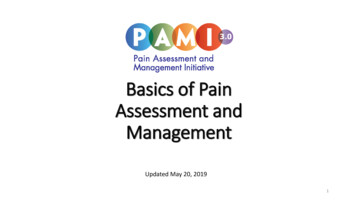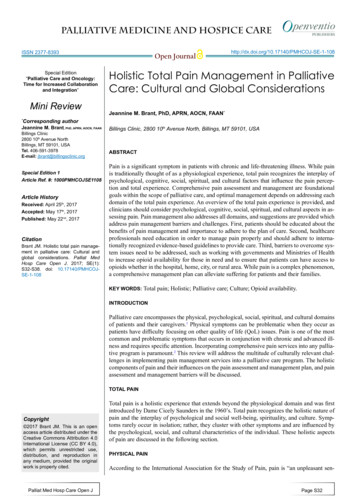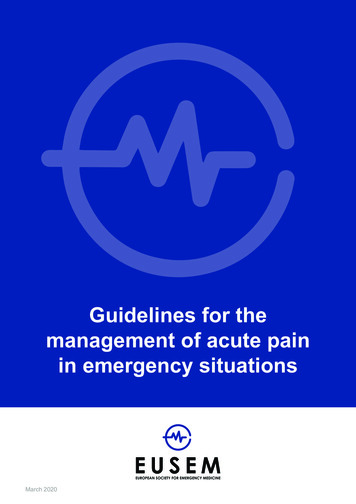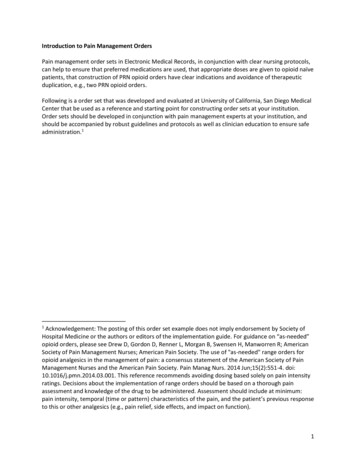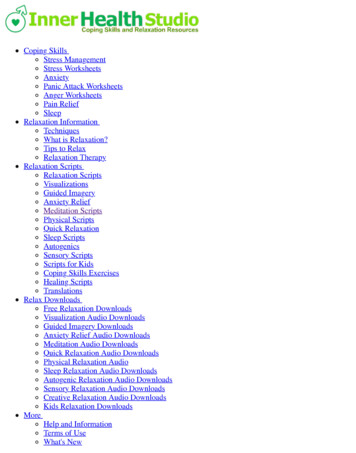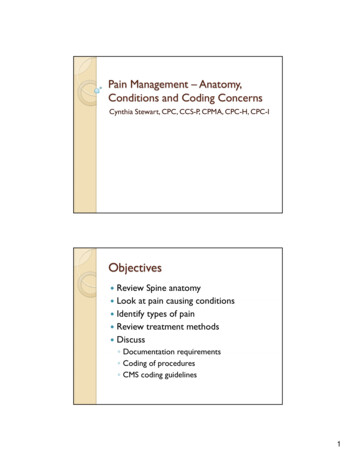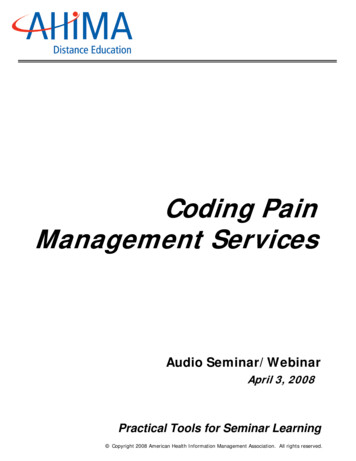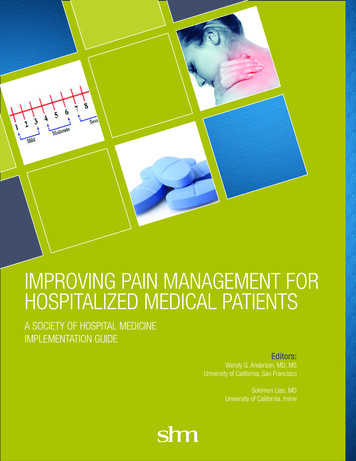
Transcription
IMPROVING PAIN MANAGEMENT FORHOSPITALIZED MEDICAL PATIENTSA SOCIETY OF HOSPITAL MEDICINEIMPLEMENTATION GUIDEEditors:Wendy G. Anderson, MD, MSUniversity of California, San FranciscoSolomon Liao, MDUniversity of California, Irvine
TableContributorsSectionof Contents1: Essential First StepsJulie W. Childers, MD, MSUniversity of PittsburghMario De Pinto, MDUniversity of California, San FranciscoProject Manager:Lauren ValentinoSociety of Hospital MedicineDebra B. Gordon, RN-BC DNP, ACNS-BC, FAANUniversity of Washington, SeattleRosene Pirrello, BPharm, RPhUniversity of California, IrvineScott Steiger, MD, FACPUniversity of California, San FranciscoMichael Stroud, PhDSan Francisco Veterans Affairs Medical CenterImproving Pain Management for Hospitalized Medical Patients
SectionTable of 1:AcknowledgmentsAcknowledgmentsContentsEssential First StepsWe would like to acknowledge the invaluable advice of Gregory Maynard, MD, MSc, SFHM,Director of the University of California San Diego Center for Innovation and Improvement Scienceand Senior Vice President of the Society of Hospital Medicine Center for Hospital Innovation andImprovement. We are also indebted to Jenica Cimino, BS, Project Coordinator at UCSF for herwork incorporating the patient perspective and trialing interventions. This project was supportedby a Pfizer medical education grant. The authors had full responsibility in designing and compilingthis Guide.1
TableSectionof Contents1: Essential First StepsSection I: Introduction. 8Improving Pain Management for Hospitalized Medical PatientsSection II: How to Implement and Sustain a Pain Management Quality ImprovementProgram for Hospitalized Medical PatientsStep 1: Form an Interdisciplinary Team with a Common Goal1.1Assembling the Core Project Team. 101.2Defining Intervention Scope and Aims. 10Step 2: Obtain Institutional Support . 11Step 3: Assess the Current State of Pain Management in Your Facility3.1Describe the Population You Aim to Serve. 123.2Identify Resources and Garner Buy-in from Stakeholders. 13Step 4: Institutional Best Practices for Hospital Pain Management4.1General Best Practices in Pain Management. 154.2 Availability of Subspecialty Services: Pain Managementand Palliative Care. 174.3Helping Staff with Difficult Conversations about Pain Management. 194.4.Systems-Level Management of Pain Medications. 204.4.1.1 Appropriate Initiation and Titration of Opioid Analgesics. 204.4.1.2 Side Effects of Opioid Analgesics. 204.4.1.3 Converting to a Discharge Regimen. 214.4.2Order Sets. 214.4.3Non-pharmacological Interventions. 224.5Special Populations. 222ImprovingQuality OpioidPain dicalto DischargePatients
SectionTable of 1:ContentsEssential First StepsStep 5: Choose Metrics and Develop a Data Collection Plan5.1Existing Pain Management Performance Metrics. 235.1.1HCAHPS Survey. 235.1.2Internal Protected Sources of Data to Drive Quality Improvement. 245.2Suggested Metrics for Hospital Pain ManagementImprovement Projects. 255.3Patient-Reported Outcome Measures. 265.4Other Outcome Measures. 27Step 6: Deploy Interventions and Monitor Impacts6.1Interventions to Ensure Engagement and Coordination of Cliniciansfrom Multiple Disciplines. 286.2Implementation of Protocols that Recognize and Treat Pain Promptly. 296.3Educational Interventions for Patients and Families. 296.4Educational Interventions for Prescribers. 306.5Safety and Ensuring Appropriate Opioid Prescribing. 31Step 7: Improving Transitions of Care for Patients with Pain7.1Elements of a “Quality” Discharge. 327.1.1Transitioning to an Outpatient Pain Regimen. 337.1.2Access to Specialists after Discharge when Appropriate. 337.1.3Cost Considerations in Outpatient Pain Regimens. 337.1.4Other Logistical Considerations when Discharging Patientson Controlled Substances. 347.1.5Assess Risk for Failure of Outpatient Management and Misuseof Outpatient Prescribed Opioids. 347.2Patient Education about Pain at Discharge. 367.3Post-discharge Resources. 37Appendix: Additional Pain Management Resources. 383
AboutSectionthe1:ProjectEssentialTeamFirst StepsWendy G. Anderson, MD, MS is Assistant Professor in the Division of the Hospital Medicine andPalliative Care Program at the University of California, San Francisco, where she has worked since 2007.She has practiced as a hospitalist physician and palliative care consultant and led quality and educationimprovement projects focused on pain management and palliative care. She leads a program of research,education and quality improvement with the goal of improving care for seriously ill hospitalized patients.Julie W. Childers, MD, MS is Assistant Professor of Medicine in the Section of Palliative Care andMedical Ethics at the University of Pittsburgh. In addition to maintaining a clinical practice in outpatientand inpatient palliative medicine, she established and directs a buprenorphine clinic to provide services topatients with opioid addiction. She teaches motivational interviewing to medical students, residents andpalliative care professionals, and is a member of the Motivational Interviewing Network of Trainers. Shehas written and taught nationally in the areas of teaching communication and treating pain in patients withco-occurring addiction disorders.Debra B. Gordon, RN-BC DNP, ACNS-BC, FAAN is a Teaching Associate with the Department ofAnesthesiology and Pain Medicine at the University of Washington, Seattle. She works in conjunction withthe inpatient and outpatient Pain Relief Services, clinics and hospital staff to collaborate on improvingsystems of care and designing outcome evaluations that benefit patients and populations across thecontinuum of care. Deb has also been involved in a number of national and international projects focusedon improving pain management including the American Pain Society’s (APS) Quality ImprovementGuidelines, the Australian National Institute of Clinical Studies (NICS) evidence-practice gap project onmanaging acute and cancer pain in hospitalized patients and the international postoperative “Pain-Out”Registry.Solomon Liao, MD is a Clinical Professor of Medicine in the Hospitalist Program at the Universityof California, Irvine and the Director of the Palliative Care Service. He has practiced as a hospitalist,geriatrician consultant and palliative medicine consultant for 16 years. During that time he has led multiplequality improvement and educational projects and research projects.Mario De Pinto, MD is an Associate Professor, Department of Anesthesiology and Perioperative Care,University of California, San Francisco, Medical Director, UCSF Pain Management Center and Director ofthe Chronic Inpatient Pain Service. Dr. De Pinto is responsible for chronic pain medicine education formedical students and anesthesiology residents.Rosene Pirrello, BPharm, RPh is a pharmacist specialist in palliative care at the University of CaliforniaIrvine Medical Center. In this role she cares for patients in both the inpatient hospital setting and theambulatory palliative care clinic. She provides education to physician, pharmacist and nursing staff andtrainees.4Improving Pain Management for Hospitalized Medical Patients
Section 1: Essential First StepsScott Steiger, MD, FACP is Assistant Professor of Clinical Medicine at the University of California,San Francisco. As a clinician educator, he provides primary care, teaches a variety of learners frompreclinical medical students to providers in practice and leads quality improvement initiatives aroundopioid management and addiction treatment for the Division of General Internal Medicine. He is alsoDiplomate of the American Board of Addiction Medicine and provides treatment for substance usedisorders in the primary care setting.Michael Stroud, MD is a clinical psychologist for addiction medicine and primary care mentalhealth service at San Francisco Veteran Affairs Medical Center. He developed a primary care-basedpain clinic for patients receiving opioid therapy for chronic non-malignant cancer pain and aberrantbehaviors. He was also involved in developing a tele-health program to provide pain psychology andpain pharmacy consultation to VA clinics in rural areas. His current work at SFVAMC focuseson individual and group pain psychology interventions in primary care.Lauren Valentino is the Manager for the Center for Hospital Innovation and Improvement at theSociety of Hospital Medicine (SHM). She also serves as the Project BOOST National ProgramManager for SHM’s care transitions program. She is responsible for supporting the Quality Initiativesdepartment through project planning and implementation. She is also a support resource for theSociety by providing documentation and coordination to the committees, task forces and variousspecial interest groups.5
Section 1: Essential First Steps6Improving Pain Management for Hospitalized Medical Patients
Section 1: Essential First StepsSection I:Introduction7
SectionSectionI: Introduction1: Essential First StepsIntroductionPain is a major public health problem affecting more American adults than heart disease, cancer anddiabetes combined. More than 116 million adults in the U.S. suffer from chronic pain, and federalexpenditures for pain care total 99 billion a year. Management of pain costs up to 635 billion eachyear in medical treatment and lost productivity.1 The negative physiological, psychological and socialconsequences of pain are well documented. A number of advances have occurred in recent decadesto improve the quality of pain management. Pain education is required in training and continuingeducation of heathcare professionals. Specialties have been created in pain management andpalliative care. Institutions have created comprehensive programs to provide expert pain managementthroughout the care continuum. The Joint Commission for the Accreditation of HealthcareOrganizations (JCAHO) accreditation program includes national standards on assessment andmanagement of pain in all settings where patients are cared for.Despite these advances, a number of gaps remain in the quality and safety of pain managementprovided to patients. Hospitalized patients continue to experience moderate to severe pain.Over-reliance on opioid-based therapies has led to significant adverse events and a nationwideepidemic of opioid misuse and diversion.3-6As frontline physicians in hospitals and leaders of quality improvement programs, hospitalists findthemselves in the cross-hairs of these national problems of inadequate pain treatment and opioidmisuse. Though pain management is a core competency for hospitalist physicians,7 many hospitalistsfind themselves under-trained to safely and adequately treat pain. Furthermore many hospitals andmedical centers lack robust and coordinated pain care systems that optimize both opioids stewardshipand patient outcomes.The goal of this Guide is to provide practical advice to hospitalist physicians and other leaders whoare developing programs to improve pain management in their services and facilities. The focus is onmedical patients, though many of the principles described here are relevant to patients recovering fromsurgical care who are increasingly co-managed by hospitalists. The following content on best practicesin pain management is drawn from a multidisciplinary national expert panel. The quality improvementpractices are drawn from our own experience as well as previous work in other fields includingprevious Society of Hospital Medicine Implementation Guides. We applaud your work to improve painmanagement for your patients and hope this Guide will be of use in your efforts.8Improving Pain Management for Hospitalized Medical Patients
Section 1: Essential First StepsSection II:How to Implement and Sustain a PainManagement Quality ImprovementProgram for Hospitalized Medical Patients9
Section II: How to Implement and Sustain a Pain ManagementSection 1: Essential First StepsQuality Improvement Program for Hospitalized Medical PatientsStep 1: Form an Interdisciplinary Team with a Common Goal1.1 Assembling the Core Project TeamThe first step in initiating a program to improve pain management at a hospital or within a service lineor unit is to form an interdisciplinary team to lead the project. Interdisciplinary pain care results inbetter health processes and outcomes for both acute and chronic pain. This coordinated approach isassociated with improved pain management during the hospital stay as well as fewer readmissions forpain management.8 An interprofessional project implementation team is essential because pain cannotbe managed alone by any one discipline or individual and collaboration helps ensure that each patientis cared for in an interdisciplinary manner. The core team should include, at a minimum, memberswith expertise in pain management and quality improvement with nursing, pharmacy and physicianrepresentatives. This core team could also include others who are very involved in pain managementat your institution, e.g., therapists, psychologists, pain or palliative care physicians and representativesfrom units and services where the project is to be implemented.1.2 Defining Intervention Scope and AimsOnce a team has been assembled, the initial vision of the project can be fleshed out. Stakeholders andteam members will likely have a number of different needs and perspectives on how to improve painmanagement. The desire to improve the patient experience and clinical care should be the commonuniting perspective. Additionally, stakeholders may be motivated by readmissions, long lengths ofstay and concern about opioid safety. All of these concerns should be voiced and used to form thecommon vision of the team regarding the outcomes to be improved. Articulating the scope and aimsof the intervention is important early on, even though these objectives may be modified followingfurther discussions with stakeholders and needs assessments. For example, will the project focuson a specific unit, service or patient population? Will the intervention focus only in the hospital ortransitioning to the home and outpatient setting as well? Is the focus on decreasing adverse eventsassociated with opioids or on improving patient function or satisfaction? Or is the focus on ensuringthat opioids are prescribed appropriately at discharge so as not to contribute to misuse or diversion?All such aims should be listed and specified. This scope and aims will inform the next steps ofobtaining buy-in and performing a needs assessment. We recommend setting aims that focus ondifferent aspects of pain management, e.g., effectiveness, safety, patient satisfaction and transitionsbetween the inpatient and outpatient setting. Choosing a balanced set of aims will ensure thatunintended consequences are tracked. For example, during roll-out of a new opioids order set, itwould be important to track the effectiveness of pain management as well as the frequency of adverseevents such as sedation or respiratory depression. Additionally aims should address the structuralcomponents of the healthcare system, such as availability of specialty pain management resources, orthe set-up of the electronic medical record (EMR), as well as process measures such as the frequencywith which pain is assessed and treated with certain medications.10Improving Pain Management for Hospitalized Medical Patients
Section II: How to Implement and Sustain a Pain ManagementSection1: Essential First StepsQuality Improvement Program for Hospitalized Medical PatientsStep 2: Obtain Institutional SupportAs with any quality improvement project, obtaining institutional support for any pain managementimprovement project is necessary for success. Obtaining support from institutional leaders iscritical because there are many competing strategic priorities in healthcare organizations, and painmanagement requires organizational resources and interdisciplinary leadership. Establishing one ormore executive sponsors who understand the need for effective pain management is an importantfirst step. This person(s) should also understand the key roles of organizational program developmentand outcomes measurement specific to pain management. This person may be a senior nurse, apharmacist or a medical executive who can help align the aims of the pain quality initiative with thestrategic mission and business goals of the organization.Recruiting sponsors who can ensure that the necessary resources are available and can help reconcilecross-functional issues within the organization should be considered. Financial support may be neededto adequately implement the project. For example, some providers who may be pivotal in improvingpain management, such as pharmacists or clinical nurse specialists, may not be able to create a billfor the service they provide. The business case for these providers may need to be made based on areturn on investment that can be expected as a result of decreased length of stay and readmissionsand increased revenue from value-based purchasing. When approaching hospital leadership regardingthe establishment of a multidisciplinary team, emphasizing that each individual provider has differentexpertise and that their experience will ultimately result in appropriate, safe and effective pain care, areduction of the waste of resources and therefore cost-saving, is important.Below are key perspectives and arguments that can be used to garner institutional support.Discussions with hospital and program leadership can help identify how the pain improvementprogram can best align with the current organizational strategic priorities. P ain is prevalent among medical patients. Institutional leaders may commonly think of painmanagement in the hospital as mostly acute pain and surgical pain. Yet pain is prevalent amongmedical patients and frequently treated with higher doses of opioid medications.3 I nadequate treatment of pain results in longer hospital length of stay and frequentreadmissions. Effective pain management is a key aspect of efforts to reduce length of hospitalstay and improve outcomes for medical and surgical patients.9,10 Patients with inadequate paincontrol after discharge are at higher risk for hospital readmission.11-13 They are less willing to bemobile and are therefore at higher risk for complications such as pressure ulcers and deep venousthrombosis. The Centers for Medicare and Medicaid Services (CMS) withholds payment fromhealthcare organizations for the costs associated with treating preventable complications. I nadequate treatment of pain is a key factor in a patient’s experience of care, and decreasespotential revenues through the Hospital Value-Based Purchasing program. This program haslinked a portion of a hospitals’ payment from CMS to performance on a set of quality measures,including patients’ satisfaction regarding pain management on the Hospital Consumer Assessmentof Healthcare Providers and Systems (HCAHPS) survey.11
Section II: How to Implement and Sustain a Pain ManagementSection1: EssentialFirst forStepsQualityImprovementProgramHospitalized Medical Patients I nappropriate use of opioid analgesics leads to significant adverse events and contributes to thenationwide epidemic of opioid misuse and diversion.3-6 Opioid-related adverse events includingpatients’ deaths consistently represent one of the largest numbers of sentinel events in the JCAHOdatabase.14 Lack of appropriate monitoring methods and protocols can contribute to opioid adverseevents and create liability for the hospital. F or accreditation, the Joint Commission requires hospitals to demonstrate excellence in thescreening and management of pain. JCAHO standards require accredited healthcare facilities to1) recognize the right of patients to appropriate assessment and management of pain; 2) assesspain in all patients; 3) record the assessment in a way that facilitates regular reassessment andfollow-up; 4) educate patients, families and providers; 5) establish policies that support appropriateprescribing or ordering of pain medications; 6) include the patients’ need for symptom control indischarge planning; and 7) collect data to monitor the appropriateness and effectiveness of painmanagement.Step 3: A ssess the Current State of Pain Managementin Your FacilityBefore an intervention is finalized and launched, a formal assessment of the current state of painmanagement at your facility should be conducted. This assessment should inform the interventionto be deployed to make sure it addresses the key areas of need and utilizes the resources available toyou. Additionally, the assessment presents an opportunity to collect baseline data on key measuresthat will be used to evaluate whether the intervention has been successful.3.1 Describe the Population You Aim to ServeOnce the scope and aims of your project have been defined, the next step is to delve deeper intothe needs of the patients you are serving in your intervention. Reports can be created through theelectronic medical record (EMR) to identify patients with high pain ratings or by diagnosis, e.g., sicklecell disease, cancer, etc. Administrative data can be reviewed to describe hospital length of stay orreadmissions in this population, as well as where patients receive outpatient care. EMR reports canalso identify patients using opioids or other medications and those with adverse events.Case and chart review in combination with EMR reports can be helpful in getting a sense of thetypes of pain and other medical problems with which your population struggles. For example, is painpredominantly acute or chronic? Is the pain characterized as to cancer-related or non-cancer-relatedpain? How often are patients on chronic opioid therapy? Do patients frequently have concomitantpsychiatric or substance abuse problems? Getting a sense of the patients you serve will help to tailoryour intervention.12Improving Pain Management for Hospitalized Medical Patients
Section II: How to Implement and Sustain a Pain ManagementSection1: EssentialFirst forStepsQuality ImprovementProgramHospitalized Medical PatientsGetting the perspectives of patients and families on their pain management is also very helpful.Comments about pain management in HCAHPS surveys can be reviewed to identify key themes.Additionally patients can be surveyed or interviewed to obtain their perspectives on what their biggestneeds are, what is working well in their pain management and what needs to be improved.3.2 Identify Resources and Garner Buy-in from StakeholdersThough significant data exists about the importance of comprehensive and coordinated pain care,many institutions have multiple resources available for pain care that are not coordinated. Conductingan environmental scan of all available resources that might serve your population can help identifyresources that can be brought to your patients and coordinated into their care as opposed to“reinventing the wheel” as part of your intervention. As you identify providers and others who areinvolved in pain care at your institution, the project team should meet with all those who 1) need to putin effort to implement the project, 2) will be impacted by it, 3) could be brought in to achieve its aimsor 4) might have objections and put up barriers. In these stakeholder discussions, the core team canget the feedback of these stakeholders on the project as well as their buy-in. Stakeholder meetings canalso lead to identification of other resources and stakeholders who should be consulted. Collaboratingwith information technology services will be a key point to explore what types of reports can begenerated to track the implementation of your intervention.The following is a list of disciplines and specialties who are often involved in pain care and whoseinput could be sought: Hospital physicians, including attending hospitalist physicians and residents if applicable Nurses, including bedside nurses, nurse managers, nurse practitioners and clinical nurse specialists Case managers, social workers and representatives from home care programs Pharmacists Physical and occupational therapists Primary care and other outpatient physicians (e.g., oncologists) Pain management specialists – inpatient and outpatient Palliative care specialists – inpatient and outpatient Spiritual care professionals Integrative medicine practitioners, e.g., massage, acupuncture, guided relaxation Health and rehabilitation psychologists P atient services — for generation of patient survey reports (e.g., HCAHPS) and liaising withvolunteer services Patient and family representatives, e.g., patient and family advisor council13
Section II: How to Implement and Sustain a Pain ManagementSection1: EssentialFirst forStepsQualityImprovementProgramHospitalized Medical PatientsThese stakeholders may have very different concerns than the institutional leadership about paincare. Stakeholder meetings can thus clarify how to make the intervention work for all stakeholders,including leadership, providers and patients.This is also a key time to catalog and describe structures and processes related to pain management atyour hospital and on your unit. Aspects to be assessed at this step include: What hospital policies guide the assessment and treatment of pain? W hat pain scales are used in your hospital and unit? How frequently is pain assessed? Do protocolsguide the reassessment of pain after an intervention? D o protocols specify how/when to monitor for opioid dose effectiveness (decrease in pain) and sideeffects using sedation scales? Are there specific protocols for patient-controlled analgesia (PCA)? D o audits, e.g., JCAHO or other hospital audits, assess how well your protocols for painmanagement and monitoring are being followed? W hat order sets include medications or other interventions for pain management? For example, dothe admission order sets include as-needed pain medications? Are there other specific order sets,such as for acute pain or PCA? Are these order sets utilized properly? A re there methods for flagging and monitoring or adjusting doses for patients who may be at riskfor adverse events related to opioids, e.g., patients with obstructive sleep apnea or renal disease? A re there hospital guidelines that regulate the use of, or who can prescribe, high-risk medicationssuch as methadone or fentanyl patches? A re pharmacy, pain management and/or palliative care automatically consulted for certain patients,e.g., patients with sickle cell disease or post-operative patients? A re there reports or audits to track the use of high-risk medications such as methadone or fentanylpatches? A re there reports or audits to track opioid adverse events such as respiratory depression, or isnaloxone use tracked?14Improving Pain Management for Hospitalized Medical Patients
Section II: How to Implement and Sustain a Pain ManagementSection1: EssentialFirst forStepsQuality ImprovementProgramHospitalized Medical PatientsStep 4: Institutional Best Practices for Hospital Pain ManagementThe following sections provide an overview of best practices in pain management at the institutionallevel. This overview is not intended to be a comprehensive guide to pain management of the individual,since many textbooks and guidelines are already available for this purpose.4.1 General Best Practices in Pain ManagementTable 1 lists the hallmarks of a high-quality pain management program.15 These key elements mustbe supported by the patient care structure and processes, so that “doing the right thing” is easierthan “doing the wrong thing.” For example, in addition to training staff that the highest daily painscore is what impacts patients the most, printouts of the pain scores should be available that allowstaff to easily track the peak pain score. Similarly the peak pain score should be discussed at dailyinterdisciplinary rounds. Along the same lines, printouts of the pain scores should allow a view of theoverall, general trend of the patient’s pain.Table 1: Hallmarks of a High-Quality Pain Management Program Ensuring appropriate assessment, including Regular evaluation of pain: on admission, throughout the hospital stay and at discharge Completion of a comprehensive initial assessment, including Prescription Drug MonitoringProgram Timely reassessments of patient responses to treatment- emphasis on maximal daily pain- emphasis on overall, general trend or directi
About the Project TeamSection 1: Essential First Steps Improving Pain Management for Hospitalized Medical Patients Wendy G. Anderson, MD, MS is Assistant Professor in the Division of the Hospital Medicine and Palliative Care Program at the University of California, San Francisco, where she has worked since 2007.




